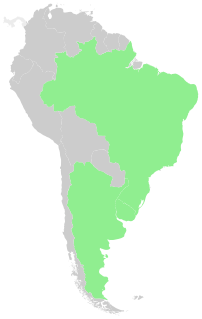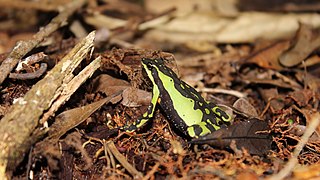
Convolvulaceae, known commonly as the bindweed or morning glory family, is a family of about 60 genera and more than 1,650 species of mostly herbaceous vines, but also trees, shrubs and herbs, and also including the sweet potato and a few other food tubers.

Neolamprologus brichardi is a species of cichlid endemic to the alkaline waters of Lake Tanganyika in East Africa. It is a popular aquarium fish kept in the fishkeeping hobby, where it is known under a variety of common names including Princess cichlid, Princess of Burundi, Lyretail cichlid, Fairy cichlid and Brichard's lamprologus. In addition, the species is also the subject of numerous studies on fish behaviour. It is closely related to N. pulcher from the southern half of Lake Tanganyika and some have recommended merging the two into a single species.

Pelvicachromis pulcher is a freshwater fish of the cichlid family, endemic to Nigeria and Cameroon. It is popular amongst aquarium hobbyists, and is most commonly sold under the name kribensis, although it has other common names, including various derivatives and color morphs of the kribensis: krib, common krib, red krib, super-red krib and rainbow krib, along with rainbow cichlid and purple cichlid.

Senecio pulcher is an ornamental plant native to the wet valleys & slopes and flooded rocky habitats in Argentina, Brazil, and Uruguay. Cited in Flora Brasiliensis by Carl Friedrich Philipp von Martius. After dusty miller, S. pulcher is perhaps one of the most popular species of the genus for horticulture along with German ivy and purple ragwort or it was in 1917.

Atelopus pulcher is a species of toad in the family Bufonidae. It is endemic to eastern Peru where it is found in the Huallaga River drainage; its range might extend to Ecuador. Its natural habitats are lowland and premontane tropical forests. It is a diurnal and terrestrial species that breeds in streams.

Hemigrammus pulcher is a semi-popular aquarium species, also known as the pretty tetra, garnet tetra or black wedge tetra. In the wild, the species is found near Iquitos in the Peruvian Amazon, and probably also in Brazil and Colombia.

Luciocephalus puncher, the pikehead, giant pikehead or crocodile pikehead, is a species of gourami native to the Malaya Peninsula, Sumatra, and Borneo. It inhabits flooded forests, streams, and peat swamps living in areas with plentiful vegetation. It is a predator and lurks for its prey among plants near the water's surface. As the prey is swallowed, the jaw extends to about one-third of the head length. the extended jaw is folded back into place. It is a mouthbrooder. It is a yellowish-brown color with dark brown longitudinal bands and stripes. This species can reach a length of 20 centimetres (7.9 in) SL. It can also be found in the aquarium trade, where it is notoriously difficult to keep; they require extremely soft, acidic water and seldom eat non living foods.

Conus pulcher, common name the butterfly cone, is a species of sea snail, a marine gastropod mollusk in the family Conidae, the cone snails and their allies.

Rumex pulcher is a species of flowering plant in the knotweed family known by the common name fiddle dock. It is native to Eurasia and North Africa and it can be found elsewhere, including parts of North America, as an introduced species and a roadside weed. Europe. It is quite variable in appearance, and some authorities divide it into several subspecies that are more or less distinguishable. In general, it is a perennial herb producing a slender, erect stem from a thick taproot, approaching 70 centimeters in maximum height. The top of the plant may bend, especially as the fruit develops. The leaves are up to 10 or 15 centimeters long and variable in shape, though often oblong with a narrow middle in the rough shape of a fiddle. The inflorescence is made up of many branches, each an interrupted series of clusters of flowers with up to 20 in each cluster, each flower hanging from a pedicel. The flower has usually six tepals, the inner three of which are edged with teeth and have tubercles at their centers.
Coenoptychus pulcher is a species of spider in the family Corinnidae, found in India and Sri Lanka.
Thapsagus is a monotypic genus of East African sheet weavers containing the single species, Thapsagus pulcher. It was first described by Eugène Louis Simon in 1894, and has only been found on Madagascar.

Trigonotylus pulcher is a species of plant bug in the family Miridae. It is found in Central America and North America.
Indiopsocus is a genus of common barklice in the family Psocidae. There are more than 30 described species in Indiopsocus.

Hedriodiscus is a genus of soldier flies in the family Stratiomyidae. There are more than 20 described species in Hedriodiscus.
Asagena pulcher is a species of cobweb spider in the family Theridiidae. It is found in the United States.
Steleops is a genus of common barklice in the family Psocidae. There are more than 20 described species in Steleops.
Djalmabatista is a genus of midges in the family Chironomidae. There are about 14 described species in Djalmabatista.
Paratriarius is a genus of skeletonizing leaf beetles in the family Chrysomelidae. There are more than 20 described species in Paratriarius. They are found in North America and the Neotropics.
Lophoscutus is a genus of ambush bugs in the family Reduviidae. There are more than 60 described species in Lophoscutus.
Eudiagogus pulcher, the sesbania clown weevil, is a species of broad-nosed weevil in the beetle family Curculionidae. It is found in North America.










